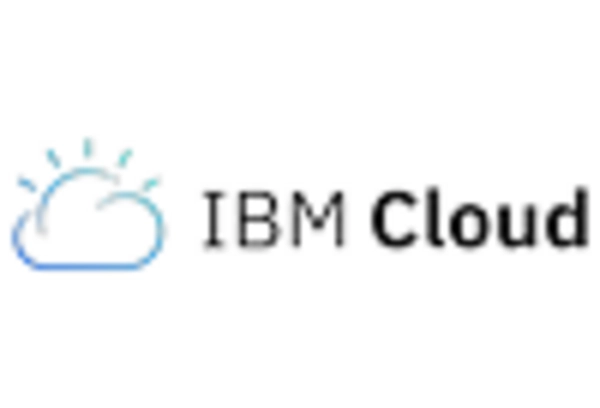Growing Emphasis on Data Analytics
The Cloud Industry Outlook Market is significantly influenced by the growing emphasis on data analytics. Organizations are increasingly leveraging cloud-based analytics tools to derive actionable insights from vast amounts of data. This trend is driven by the recognition that data-driven decision-making can enhance operational efficiency and competitive advantage. Recent reports indicate that the global market for cloud analytics is projected to reach approximately 100 billion dollars by 2025. As businesses continue to prioritize data analytics, the demand for cloud solutions that facilitate real-time data processing and visualization is likely to increase. Consequently, the Cloud Industry Outlook Market is expected to evolve, offering more sophisticated analytics capabilities that empower organizations to harness the full potential of their data.
Shift Towards Remote Work Solutions
The shift towards remote work solutions is a pivotal driver for the Cloud Industry Outlook Market. As organizations adapt to new work environments, there is a growing reliance on cloud-based tools that enable collaboration and productivity from any location. This trend is underscored by the increasing adoption of Software as a Service (SaaS) applications, which facilitate seamless communication and project management. Recent data indicates that the SaaS market is projected to exceed 300 billion dollars by 2025, reflecting the rising demand for remote work solutions. As companies continue to embrace flexible work arrangements, the Cloud Industry Outlook Market is likely to expand, providing innovative solutions that cater to the needs of remote teams.
Rising Demand for Scalable Solutions
The Cloud Industry Outlook Market is experiencing a notable increase in demand for scalable solutions. Organizations are increasingly seeking cloud services that can grow alongside their business needs. This trend is driven by the necessity for flexibility in resource allocation, allowing companies to adjust their cloud usage based on fluctuating workloads. According to recent data, the cloud services market is projected to reach a valuation of over 800 billion dollars by 2025, indicating a robust growth trajectory. This demand for scalability is particularly evident in sectors such as e-commerce and digital media, where rapid changes in consumer behavior necessitate agile cloud solutions. As businesses continue to prioritize scalability, the Cloud Industry Outlook Market is likely to evolve, offering more tailored solutions that cater to diverse operational requirements.
Increased Investment in Cloud Infrastructure
Investment in cloud infrastructure is a critical driver for the Cloud Industry Outlook Market. Organizations are allocating substantial resources to enhance their cloud capabilities, recognizing the importance of robust infrastructure in supporting digital transformation initiatives. Recent statistics suggest that capital expenditures on cloud infrastructure are expected to surpass 200 billion dollars by 2025. This investment trend is fueled by the need for improved performance, reliability, and security in cloud services. Companies are increasingly adopting advanced technologies such as edge computing and serverless architectures, which require significant infrastructure upgrades. As a result, the Cloud Industry Outlook Market is likely to witness a surge in innovative solutions that address the evolving demands of businesses seeking to optimize their cloud environments.
Emergence of Industry-Specific Cloud Solutions
The emergence of industry-specific cloud solutions is shaping the Cloud Industry Outlook Market. Organizations are increasingly seeking tailored cloud services that address the unique challenges and requirements of their respective sectors. This trend is driven by the realization that generic cloud solutions may not adequately meet the specialized needs of industries such as healthcare, finance, and manufacturing. Recent market analysis suggests that the demand for industry-specific cloud solutions is expected to grow significantly, with projections indicating a market size of over 150 billion dollars by 2025. As businesses pursue greater efficiency and compliance, the Cloud Industry Outlook Market is likely to witness a proliferation of customized offerings that enhance operational effectiveness across various sectors.


















Leave a Comment